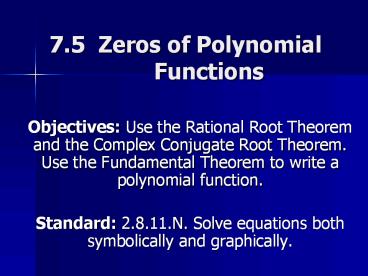7.5 Zeros of Polynomial Functions - PowerPoint PPT Presentation
1 / 18
Title:
7.5 Zeros of Polynomial Functions
Description:
7.5 Zeros of Polynomial Functions Objectives: Use the Rational Root Theorem and the Complex Conjugate Root Theorem. Use the Fundamental Theorem to write a polynomial ... – PowerPoint PPT presentation
Number of Views:256
Avg rating:3.0/5.0
Title: 7.5 Zeros of Polynomial Functions
1
7.5 Zeros of Polynomial Functions
- Objectives Use the Rational Root Theorem and the
Complex Conjugate Root Theorem. Use the
Fundamental Theorem to write a polynomial
function. - Standard 2.8.11.N. Solve equations both
symbolically and graphically.
2
The Rational Root Theorem can be used to identify
possible roots of polynomial equations with
integer coefficients. Rational Root Theorem Let
P be a polynomial function with integer
coefficients in standard form. If p/q (in lowest
terms) is a root of P(x) 0, then p is a factor
of the constant term of P and q is a factor of
the leading coefficient of P.
3
(No Transcript)
4
(No Transcript)
5
(No Transcript)
6
8x3 10x2 - 11x 2 0
7
(No Transcript)
8
Q(x) x3 - 6x2 7x 2
9
Q(x) x3 4x2 6x 12
10
Ex 3. Find all of the zeros of Same as above,
but you will get an imaginary .
- P(x) 3x 3 10x 2 10x 4
11
P(x) x3 - 9x2 49x 145
12
P(x) -4x 3 2x2 x 3
13
Writing a Polynomial when given the factors
Write the factored form and standard form of a
polynomial equation whose zeros are 3, -3, and 0
14
Complex Conjugate Root Theorem If P is a
polynomial function with real-number
coefficients and a bi (where b ? 0) is a root
of P(x) 0, then a bi is also a root of P(x)
0.
15
(No Transcript)
16
(No Transcript)
17
PSSA Warm-Up Question Algebra II Chp 7
- Standard 2.8.11 S Analyze linear, polynomial, and
rational functions. - How can you identify and describe functions and
their graphs? What are the functions zero(s)? - 1). Linear Function y ½x 2
- 2). Quadratic Function y x2 2x 3
- 3). Cubic Function y x3 4x
18
Review of Zeros of Polynomial Functions































